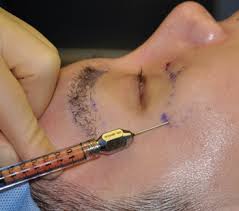The use of fat for soft tissue augmentation and in various reconstructive problems is now widely used. While it may not always survive as well as often as would be desired, and occasionally survives and grows too well, its easy accessibility and introduction into tissues lends itself to broad applications.

Augmenting the soft tissue volume of the lower eyelid and cheeks certainly seems to provide support or a push upward on the lower eyelid if enough volume is placed. While that effect seems intuitive and sometimes obvious during surgery, does it really create a noticeable effect on the lower eyelid position and is it maintained long term?
In the May 2014 issue of the Journal of Ophthalmic Plastic and Reconstructive Surgery, an article appeared entitled ‘Effect of Autologous Fat Injection on Lower Eyelid Position’. In this paper, seventy (70) patients over a four year period underwent fat injections to the cheek and lower eyelid tear trough for aesthetic augmentation. Its effect on lower eyelid position was measured by marginal reflex distance and inferior scleral show on before and after treatment pictures. A mean decrease in marginal reflex distance and a mean change (lessening) in scleral show of 0.5mms was found in both eyes with an average follow-up of just over four months. Only some temporary after treatment induration of the eyelid skin was seen in a few patients. (7%) The authors conclude that fat injections appear to augment support to the lower eyelid and may be useful in the treatment of lower eyelid retraction.
While the use of fat injections will continue to be used for tear trough and cheek augmentation due its simplicity compared to implants, its effective has been primarily judged by volume retention. Increased lower eyelid support suggests that it may have a role in the treatment of lower eyelid ectropion/retraction as well. Downward positioning of the lower eyelid has long been known to be caused by a relative tissue loss aggravated by the pull of cicatricial forces if present after lower eyelid surgery. Injecting fat adds tissue volume as well as helps break up and loosen scar tissue. Injecting fat as a preparatory step before lower eyelid suspension or lateral canthoplasty, or in some cases as a stand alone procedure, may be a useful technique for challenging cases of lower eyelid positional problems.
Dr. Barry Eppley
Indianapolis, Indiana


